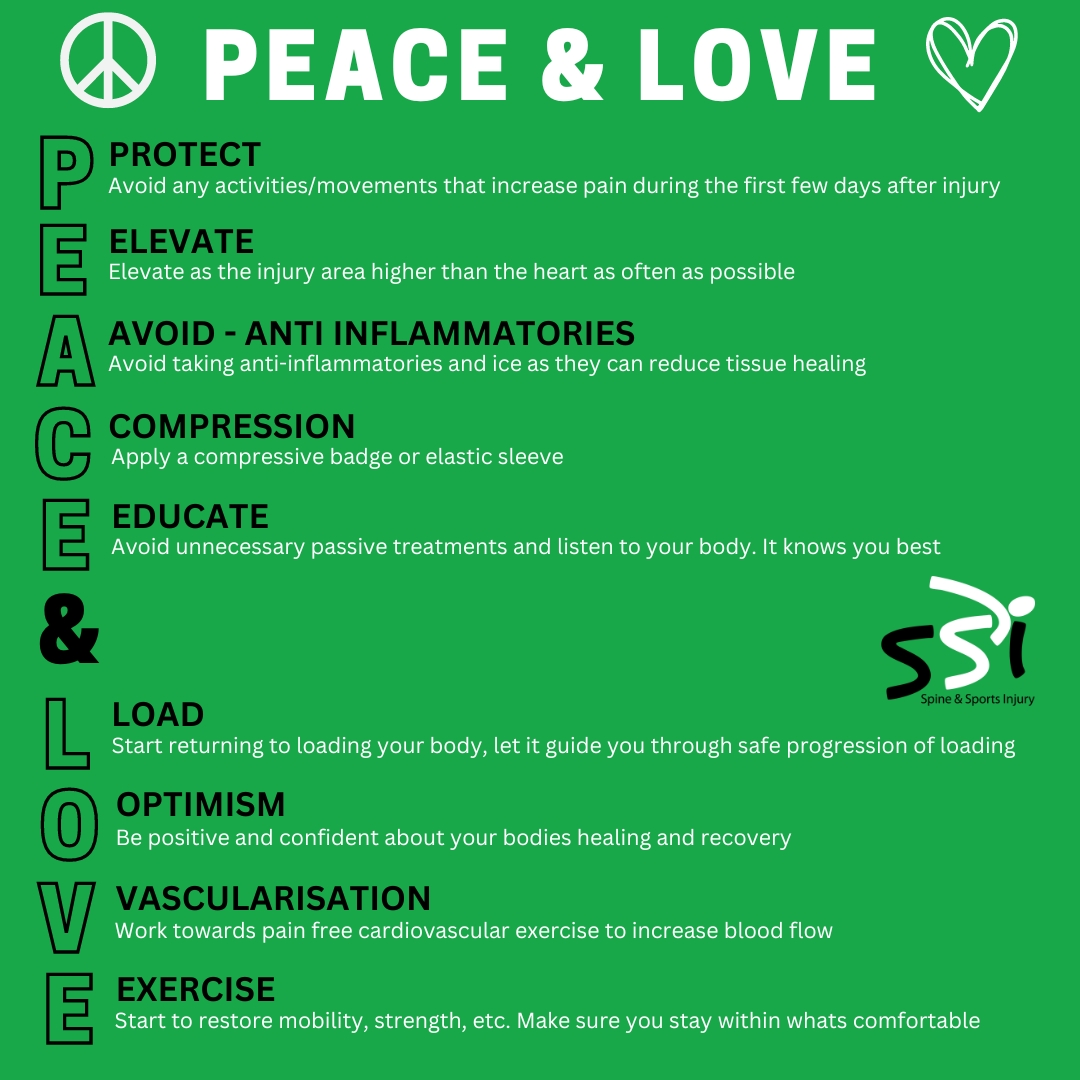PEACE & LOVE Injury Management

Do you know about PEACE & LOVE? Gone are the days of RICE and PRICE, this is the most updated research about what to do after an injury to you back on track in the quickest time frame.
P = Protect
Unload or restrict movements that cause pain for the first few days. The aim being to reduce aggravating the injury, prevent distension of injured fibres and reduce bleeding. However, you don’t want to rest all day long, this will reduce your tissue strength. So, try not to lay down all day and move little and often listening to what your body lets you do with gradual removal of protection and introduction to reloading.
E = Elevate
The aim here is to try and elevate the injury site about the heart if possible. For example, keeping your ankle elevated after an ankle sprain. The aim of this is that is promotes interstitial fluid/toxin removal from the injured tissue. But evidence is lacking if this is beneficial or not. So it’s up to you to try it out and see if it works for you.
A = Avoid Anti-inflammatories
The natural stage of healing after injury is inflammation, this is how we know our body is working to repair. Therefore, taking medication to reduce this effect can inhibit the bodies natural response and impair the healing process. Additionally avoiding ice is the most current approach, ice is considered to also delay the healing of injuries, however if ice works for you in the first few days to manage your pain then keeping icing, just not for too long.
C = Compression
Compressive bandages can be used to limit tissue haemorrhage and intra-articular edema. But again, evidence supporting this element is slim and it can be injury dependent. So this is one you could always skip. Also seek advice if you feel you may benefit from a compressive bandage for your injury.
E = Educate
It’s important to try to understand your own injury. Whether thats advice you’ve found yourself online to see what your next steps are for recovery, or advice we can give you during an injury assessment. An Active approach to your recovery is always best and passive treatments will not help you recover. So read up or reach out to us for education around your injury.
PEACE OUT ???
The PEACE phases normally lasts around 2-3 days now that has passed we move onto LOVE.
L = Love
Musculoskeletal injuries benefit from an active approach with movement and exercise. Therefore when you are able to tolerate load its great to slowly start to integrate gradual load without extreme pain when moving. Some pain may occur but as long as its within pain levels we are promoting tissue repair and remodelling
O = Optimistic
We can be quite negative when we get injured and that’s understandable but having a positive outlook and believing you will recover puts you in the best place to give your rehab and recovery everything you’ve got!
V = Vascularisation
Get up and get moving in a pain free way. If your body is letting you, an introduction of cardiovascular activity will increase blood flow round the body to injured structures as well as boost your mood and make you feel good. Additionally, cardio work will help to improve your function and reduce the need for pain medication
E = Exercise
When your able to exercise is your best friend! Active recovery is the best thing for you. Listen to your body and focus on what you’re able to do within pain tolerance and use this pain to guide your progress when you are ready. Exercise is going to help to restore mobility, restore strength and restore proprioception.
So, hopefully this short introduction will help to give you all an updated understanding on what to do after suffering with an injury. If you want further information or aren’t sure on the steps to take then get in contact with us or book a Sports Therapy Initial Consultation online I can assess your injury and get your rehab underway.
If you want to read in more detail - Dubois, B,. and Esculier, J.F., 2020. Soft-tissue injuries simply need PEACE and LOVE.
Sports Therapist
References:
British journal of sports medicine, 54(2), pp.72-73.